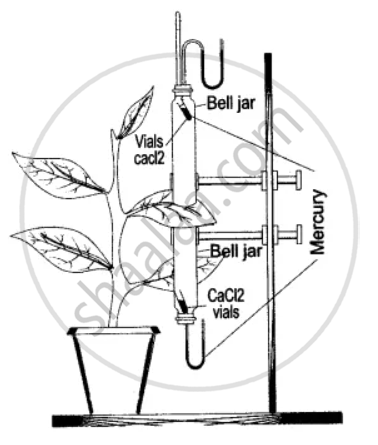Advertisements
Advertisements
Question
Given below is the diagram of an experimental set up to study the process of transpiration in plants. Study the same and then answer the questions that follow:

(i) What is the colour of dry cobalt chloride paper?
(ii) Is the experimental leaf a monocot or a dicot? Give a reason to support your answer.
(iii) Why axe glass slides placed over the dry cobalt chloride papers?
(iv) After about half an hour what change, if any, would you expect to find in the cobalt chloride paper placed on the dorsal and ventral sides of the leaf? Give a reason to support your answer.
(v) Define the term ‘transpiration’.
Solution
(i) The colour of dry cobalt chloride paper is blue.
(ii) Dicot leaf. It has reticulate venation.
(iii) To prevent water vapour of the air from interfering the experiment. .
(iv) The cobalt chloride paper placed on the lower surface of the leaf will show more pink dots as there are more stomata. The upper surface has less stomata than the lower surface.
(v) Loss of water as water vapour from the aerial parts of the plant.
APPEARS IN
RELATED QUESTIONS
Distinguish between the following:
Stomata and lenticels
State the functions of guard cells.
The apparatus shown here is Girreau’s poto-meter designed to demonstrate unequal transpiration from the two surfaces of a dorsiventral leaf. Before keeping the leaf in between the cups, anhydrous calcium chloride (CaCl2) contained in two small vials were weighed and placed in both the cups. The ends of the cups were closed with corks through which two mercury manometers were connected. After a few hours, CaCl2 vials were taken out and weighed again.
(i) What is the purpose of keeping CaCl2 vials inside the cup?
(ii) After a few hours, the CaCl2 vials were taken out and weighed again. Will you expect any difference in weight? If so, give reasons.
(iii) What was the purpose of using a mano-meter?
(iv) What do you mean by transpiration?
Give Technical Term
Opening found on the undersurface of the dorsiventral leaf.
Name the following:
A plant having sunken stomata.
Guard cells help in regulating the ______.
Assertion (A): The loss of excess water from the aerial parts of the plant in the form of water vapor is known as transpiration.
Reason (R): Stomata of the leaf perform transpiration.
Maximum transpiration occurs through ______.
The upper layer of mesophyll in a leaf consists of elongated ground tissue called ______.
Give a reason/suitable explanation.
Leaves of some plants wilt during midday and recover in the evening.
